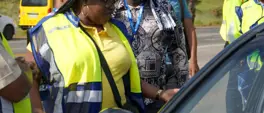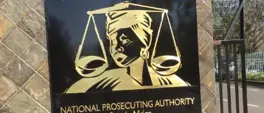MALAIKA MAHLATSI: The US government executing an innocent man should terrify us all
Malaika Mahlatsi
25 September 2024 | 16:17The real horror in this story is not only that an innocent Marcellus Wiliams was executed by the state of Missouri, but that this has happened before, writes Malaika Mahlatsi.
In the early evening of the 24th of September 2024, the state of Missouri in the United States (US) executed an innocent man.
Marcellus Williams had been sitting on death-row for 23 years after being convicted of the murder of a White woman, Felicia Gayle. Gayle, who was a former reporter for the St. Louis Post-Dispatch, was found brutally murdered in her home on the 11th of August 1998. She had been stabbed multiple times.
Her case went cold after police failed to apprehend a suspect. This all changed when a man named Henry Cole, who was serving time in prison, claimed to the police that Williams had confessed to the murder.
Cole claimed that another individual, Laura Asaro, could corroborate the story. But there were four problems with this.
A QUESTIONABLE PROSECUTION
Firstly, both Cole and Asaro were not credible witnesses. They had lengthy criminal records and were known to be dishonest individuals. Asaro had had a brief relationship with Williams at some point and had a score to settle.
Secondly, the confession that was made by Cole contained information that was already in the public domain. He effectively regurgitated information that had already been reported on in the media.
Thirdly, Cole had an incentive to accuse William of the murder. Not only was there reward money for the successful apprehension of the murderer of Gayle, but Missouri police also promised leniency and a reduction of jailtime for Cole if he testified against Williams.
But the final and most concerning problem is that the crime scene where Gayle had been brutally murdered had a lot of forensic evidence including fingerprints, hair and footprints. Additionally, there was trace DNA evidence found on the murder weapon – a knife that the killer had taken from Gayle’s own kitchen.
This DNA from the crime scene (which was re-tested as recently as 2016) did not belong to Williams. Despite this, a jury of 11 White people and 1 Black person convicted Williams of the murder and sentenced him to death.
THE DESPERATION TO KILL AN INNOCENT MAN
Since his conviction, Williams had proclaimed his innocence. He was supposed to have been executed in 2015. However, the Missouri Supreme Court stayed his execution and appointed a special master to review DNA testing of potentially exculpatory evidence.
After the testing was completed, but without conducting a hearing or making any findings based on the outcome of the testing, the appointed special master sent Williams’s case back to the Missouri Supreme Court. That court, also without considering the DNA testing results, again scheduled Williams’s execution.
On the 22nd of August 2017, mere hours before he was to be executed, Williams received a stay of execution from then-Governor Eric Greitens. Wiliams had already had his final meal.
Governor Greitens argued that the new DNA results raised serious doubts about Williams’s guilt. As a result, he convened a Board of Inquiry to once again investigate the case.
The Board’s investigation went on for a number of years, during which time, a new governor was elected in Missouri. But while the Board of Inquiry’s review was ongoing, the new governor, Mike Parson, without warning or notice, dissolved it without a report or recommendation from the Board.
Immediately after Governor Parson dissolved the Board of Inquiry, Missouri Attorney General Andrew Bailey sought a new execution date for Williams. This was in complete violation of the US constitution rights as, under the constitution and Missouri law, the stay was to remain in place until the Board of Inquiry concluded its review and issued a formal report.
As a way of bringing a conclusion to a debilitating case, Williams decided that many innocent people have made in the US to save themselves from death-row. He entered an Alford plea following an agreement with the St. Louis County Prosecuting Attorney’s Office that he would get life in prison without the possibility of parole, but not the death sentence.
An Alford plea is not a guilty plea. It is basically an accused person admitting that there is sufficient evidence to support their conviction. The Gayle family supported this, making it clear that they did not want Williams to be executed.
This should’ve been the end of the matter, but the Missouri Attorney General, Andrew Bailey, sought a writ of prohibition from the Missouri Supreme Court ordering the circuit court to hold the previously scheduled evidentiary hearing.
The Supreme Court granted it.
Subsequently, the circuit court ruled that despite the DNA evidence exonerating him, clear racial bias on the part of an overwhelmingly White jury that convicted a Black man, and ineffective legal counsel in the trial, there was not enough evidence to find Williams innocent.
The court thus confirmed the death sentence and set the date of execution for the 24th of September 2024. Despite many petitions and protests against this, from the Gayle family to the Innocence Project, an organisation that works to prevent wrongful executions and free innocent people who are wrongfully convicted.
And so, a few hours ago, Williams, an accomplished poet who has been an exemplary prison inmate, was put to death by lethal injection. His final words were: “All praise be to Allah in every situation!!!”
RACISM AND THE PRISON-INDUSTRIAL COMPLEX
The real horror in this story is not only that an innocent man was executed by the state of Missouri, but that this has happened before. There are tens of thousands of innocent men and women in American prisons.
According to a recent article by Jan Reiss published in the Harvard Public Health Magazine, conservative estimates suggest that 1% of the 2.2 million individuals in US prisons are innocent, meaning that at least 22,000 people are behind bars for crimes they did not commit.
More than 600 cases of wrongful convictions have been overturned in the US over the years. In many of these cases, DNA exonerated the accused persons. Furthermore, statistics from the Innocence Project indicate that in 16% of these cases, people were falsely convicted based on the statements of jailhouse informants, many of whom were given incentives by the police or prosecutors, including the reduction of sentences.
Furthermore, 47% of convictions are due to unvalidated or improper forensics, while 28% are based on false confessions and admissions of guilt.
The prison demographics in the US are horrific – and the numbers demonstrate just how bad it is.
The country has 4.4% of the total global population, and 22% of the total prison population in the world. To be specific, there are more than 2.2 million people who are incarcerated in the US – an increase by more than 700% in the last four decades.
And the racial construct of this is evidenced in a report by Pew Research Center, which argued that despite making up just 12% of the adult population in the US, Black people make up 33% of the prison population while Whites, who account for 64% of the adult population, make up only 30% of prisoners.
This is not an accident of history, but the outcome of racist policies of the late 1980s and 1990s that criminalised Black people in poor neighbourhoods through mechanisms such as lengthy criminal sentences for misdemeanours.
The execution of Williams is a sobering reminder of the horrors of racism and the dangers of the death penalty that so many South Africans ignorantly believe is the solution to the high crime rate.
When a criminal justice system is dysfunctional and the colour of one’s skin determines the kind of justice they receive, the death penalty becomes a tool to entrench and perpetuate racial violence.
Malaika Mahlatsi is a geographer and researcher at the Institute for Pan African Thought and Conversation. She is a PhD in Geography candidate at the University of Bayreuth in Germany.
Get the whole picture 💡
Take a look at the topic timeline for all related articles.















